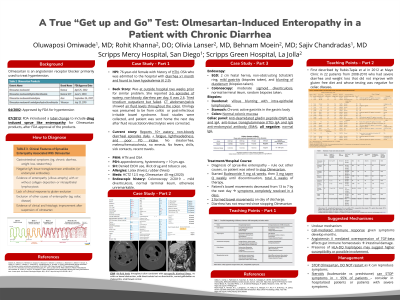Tuesday Poster Session
Category: Small Intestine
P4950 - A Case of Olmesartan-Induced Enteropathy in Patient With Persistent Watery Diarrhea
Tuesday, October 29, 2024
10:30 AM - 4:00 PM ET
Location: Exhibit Hall E

Has Audio

Oluwaposi Omiwade, MD
Scripps Mercy Hospital
San Diego, CA
Presenting Author(s)
Oluwaposi Omiwade, MD1, Rohit Khanna, DO2, Olivia Lasner, MD3, Sajiv Chandradas, MD1, Behnam Moein Jahromi, MD4
1Scripps Mercy Hospital, San Diego, CA; 2Scripps Green Hospital, San Diego, CA; 3Scripps Green Hospital, La Jolla, CA; 4Scripps Clinic, Oceanside, CA
Introduction: Olmesartan is an angiotensin receptor blocker (ARB) that is used to treat hypertension. In July 2013, the FDA added a label change for Olmesartan, as it was found to be associated with drug-induced sprue-like enteropathy. We present a case report on a patient with persistent watery diarrhea who was found to have Olmesartan-induced sprue like enteropathy.
Case Description/Methods: A 76-year-old patient with hypertension (on Hydrochlorothiazide and Olmesartan) presented with one month of worsening watery, non-bloody diarrhea. Stool studies, including stool O&P, C. difficile antigen/toxin, enteric pathogen panel, were negative. CT abdomen and pelvis showed air fluid levels in the small/large bowel, and diverticulosis, but no diverticulitis or colitis. Etiology was presumed to be post-infectious IBS or viral gastroenteritis. The patient was discharged on loperamide; however, she returned 2 weeks later with 10+ episodes of diarrhea, hypokalemia, and non-anion gap acidosis. EGD showed mild gastritis and blunting of the duodenum. Colonoscopy showed moderate sigmoid diverticulosis, normal terminal ileum. Duodenal biopsy showed villous blunting with intraepithelial lymphocytes, while colonic biopsy was normal, no microscopic colitis. Interestingly, the patient’s celiac disease panel, including anti-gliadin peptide IgG/IgA, anti-tissue transglutaminase IgG/IgA, was negative; total serum IgA was normal. Due to a normal celiac panel, there was concern for drug-induced sprue-like enteropathy. The decision was made to stop Olmesartan, as this was the likely cause of patient’s symptoms. Patient was also started on a 6-week budesonide taper. The patient’s diarrhea decreased within 4 days of treatment, and bowel movements returned to normal in 1 week. The diarrhea has not recurred since treatment.
Discussion: Clinical features of ARB-induced sprue-like enteropathy include GI symptoms such as diarrhea, weight loss that occurs months or years after being on an ARB, evidence of villous atrophy with intraepithelial lymphocytosis or collagen deposition, negative celiac serologies, or a lack of response to gluten exclusion. The mechanism for ARB-induced enteropathy is unclear, but one proposed theory is via angiotensin II mediated over-expression of TGF-beta, which can damage the intestinal mucosa. Treatment includes removal of the offending medication (such as Olmesartan), but steroids such as budesonide and prednisone are effective and can be prescribed in hospitalized patients.
Disclosures:
Oluwaposi Omiwade, MD1, Rohit Khanna, DO2, Olivia Lasner, MD3, Sajiv Chandradas, MD1, Behnam Moein Jahromi, MD4. P4950 - A Case of Olmesartan-Induced Enteropathy in Patient With Persistent Watery Diarrhea, ACG 2024 Annual Scientific Meeting Abstracts. Philadelphia, PA: American College of Gastroenterology.
1Scripps Mercy Hospital, San Diego, CA; 2Scripps Green Hospital, San Diego, CA; 3Scripps Green Hospital, La Jolla, CA; 4Scripps Clinic, Oceanside, CA
Introduction: Olmesartan is an angiotensin receptor blocker (ARB) that is used to treat hypertension. In July 2013, the FDA added a label change for Olmesartan, as it was found to be associated with drug-induced sprue-like enteropathy. We present a case report on a patient with persistent watery diarrhea who was found to have Olmesartan-induced sprue like enteropathy.
Case Description/Methods: A 76-year-old patient with hypertension (on Hydrochlorothiazide and Olmesartan) presented with one month of worsening watery, non-bloody diarrhea. Stool studies, including stool O&P, C. difficile antigen/toxin, enteric pathogen panel, were negative. CT abdomen and pelvis showed air fluid levels in the small/large bowel, and diverticulosis, but no diverticulitis or colitis. Etiology was presumed to be post-infectious IBS or viral gastroenteritis. The patient was discharged on loperamide; however, she returned 2 weeks later with 10+ episodes of diarrhea, hypokalemia, and non-anion gap acidosis. EGD showed mild gastritis and blunting of the duodenum. Colonoscopy showed moderate sigmoid diverticulosis, normal terminal ileum. Duodenal biopsy showed villous blunting with intraepithelial lymphocytes, while colonic biopsy was normal, no microscopic colitis. Interestingly, the patient’s celiac disease panel, including anti-gliadin peptide IgG/IgA, anti-tissue transglutaminase IgG/IgA, was negative; total serum IgA was normal. Due to a normal celiac panel, there was concern for drug-induced sprue-like enteropathy. The decision was made to stop Olmesartan, as this was the likely cause of patient’s symptoms. Patient was also started on a 6-week budesonide taper. The patient’s diarrhea decreased within 4 days of treatment, and bowel movements returned to normal in 1 week. The diarrhea has not recurred since treatment.
Discussion: Clinical features of ARB-induced sprue-like enteropathy include GI symptoms such as diarrhea, weight loss that occurs months or years after being on an ARB, evidence of villous atrophy with intraepithelial lymphocytosis or collagen deposition, negative celiac serologies, or a lack of response to gluten exclusion. The mechanism for ARB-induced enteropathy is unclear, but one proposed theory is via angiotensin II mediated over-expression of TGF-beta, which can damage the intestinal mucosa. Treatment includes removal of the offending medication (such as Olmesartan), but steroids such as budesonide and prednisone are effective and can be prescribed in hospitalized patients.
Disclosures:
Oluwaposi Omiwade indicated no relevant financial relationships.
Rohit Khanna indicated no relevant financial relationships.
Olivia Lasner indicated no relevant financial relationships.
Sajiv Chandradas indicated no relevant financial relationships.
Behnam Moein Jahromi indicated no relevant financial relationships.
Oluwaposi Omiwade, MD1, Rohit Khanna, DO2, Olivia Lasner, MD3, Sajiv Chandradas, MD1, Behnam Moein Jahromi, MD4. P4950 - A Case of Olmesartan-Induced Enteropathy in Patient With Persistent Watery Diarrhea, ACG 2024 Annual Scientific Meeting Abstracts. Philadelphia, PA: American College of Gastroenterology.

